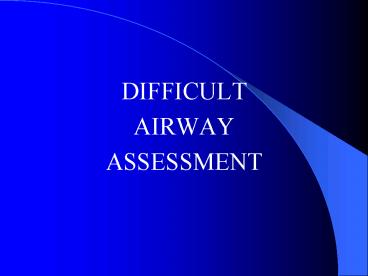DIFFICULT - PowerPoint PPT Presentation
1 / 27
Title:
DIFFICULT
Description:
The difficulty bagging these is not solely due to their increased body mass, but ... option is to leave them in while bagging and then take them out for the ... – PowerPoint PPT presentation
Number of Views:42
Avg rating:3.0/5.0
Title: DIFFICULT
1
- DIFFICULT
- AIRWAY
- ASSESSMENT
2
- This is a discussion on assessing the difficult
airway. - You will review different mnemonics for each
phase of the process.
3
MOANS, LEMON, SHORT, RODS
- MOANS Difficult Mask Ventilation
- LEMON Difficult Laryngoscopy
- SHORT Difficult Cricothyrotomy
- RODS Difficult EGD (extra-glottic device)
4
MOANS
- M Mask Seal
- O Obesity/Obstruction
- A Aged
- N No Teeth
- S Stiff
5
MASK SEAL
- Bushy beards, crusted blood on the face, or a
disruption of lower facial continuity (lower
facial fractures).
6
OBESITY/OBSTRUCTION
- Pts who are obese, women in third-trimester.
The difficulty bagging these is not solely due to
their increased body mass, but can be due to
redundant tissue creating resistance to air flow.
- Obstructions can be in the form of angioedema,
upper airway abscesses, epiglottitis and others.
7
AGED
- Age older than 55 years, due to loss of muscle
and tissue tone in the upper airway. - (55 is not a precise cutoff)
8
NO TEETH
- An Adequate mask seal may be difficult in the
edentulous pt because the face tends to cave in. - An option is to leave them in while bagging and
then take them out for the intubation.
9
STIFF
- This refers to pts that have stiff lungs
- (hard to bag)
- Pts with reactive airway disease with small
airway obstruction, pulmonary edema, ARDS,
advanced pneumonia, and other conditions that
reduces pulmonary compliance.
10
LEMON
- L Look Externally
- E - Evaluate
- M - Mallampati
- O Obstruction/Obesity
- N Neck Mobility
11
Look Externally
- Does the airway look difficult, do you have a
feeling that this will be difficult - Lower facial fractures, bleeding, obese, agitated
pt, short neck, small mouth
12
Evaluate
- The 3-3-2 Rule
- (Using pts fingers)
- Mouth opens 3 fingers or more
- Mandible is 3 fingers or more
- Glottis / Tongue 2 fingers or more
13
Mallampati Scale
- Class I soft palate, fauces, uvula, pillars
- Class II soft palate, fauces, portion of uvula
- Class III soft palate, base of uvula
- Class IV hard palate only
14
Obstruction/Obesity
- 4 cardinal signs of upper airway obstruction
Muffled voice, difficulty swallowing secretions,
stridor, and a sensation of dyspnea. - Pts who are obese, women in third-trimester.
The difficulty bagging these is not solely due to
their increased body mass, but can be due to
redundant tissue creating resistance to air flow.
15
Neck Mobility
- Cervical Spine Immobilization, ankylosing
spondylitis (It affects joints in the spine and
the sacroilium in the pelvis, causing eventual
fusion of the spine) , rheumatoid arthritis.
16
SHORT
- S Surgery
- H Hematoma/Infection
- O Obese
- R Radiation
- T Tumor
17
Surgery
- Or Airway Disruption
- The anatomy may be subtly or obviously distorted.
18
Hematoma/Infection
- A hematoma (post-op or traumatic) or an infective
process in the pathway or the cricothyrotomy may
make the procedure technically difficult, but
should never be considered a contraindication in
a life-threatening situation.
19
Obese
- This includes any access problem. Should be
considered for any problem that makes access
difficult. Short neck, large descending pannus,
sub-q air.
20
Radiation
- Past radiation therapy may distort and scar
tissues making the process difficult. - Like wise, a fixed flexion deformity of the spine
may limit the working access to landmarks.
21
Tumor
- Tumor, either in or around the airway may present
difficulty from both an access and bleeding
perspective.
22
RODS
- R Restricted Mouth Opening
- O Obstruction
- D Distorted Airway
- S - Stiff
23
Restricted Mouth Opening
- Depending on the EGD to be employed, more or less
oral access may be needed.
24
Obstruction
- Upper airway obstruction at the level of the
larynx or below. - An EGD will not bypass this obstruction.
25
Distorted Airway
- The seat and seal using the EGD will be
difficult. - Fixed flexion deformity of the neck, or with
upper airway distortion form angioedema.
26
Stiff
- Stiff lungs or cervical spine.
- Ventilation with an EGD may be difficult or
impossible. - Because of increased airway resistance (asthma)
or decreased compliance - (pulmonary edema).
- There are reports of difficult LMA insertion in
pts. With limited neck movement.
27
Cormack-Lehane SystemAnother Tool to Determine
Difficult Intubation
- Class I the vocal cords are visible
- Class II the vocals cords are only partly
visible - Class III only the epiglottis is seen
- Class IV the epiglottis cannot be seen.






























![get⚡[PDF]❤ New York Post Electrifying Su Doku: 150 Difficult Puzzles PowerPoint PPT Presentation](https://s3.amazonaws.com/images.powershow.com/10084057.th0.jpg?_=20240723035)
![❤[PDF]⚡ 120 Difficult & Extreme Adult Mazes Vol.1: Challenging Mazes Puzzle Book PowerPoint PPT Presentation](https://s3.amazonaws.com/images.powershow.com/10085048.th0.jpg?_=20240724058)